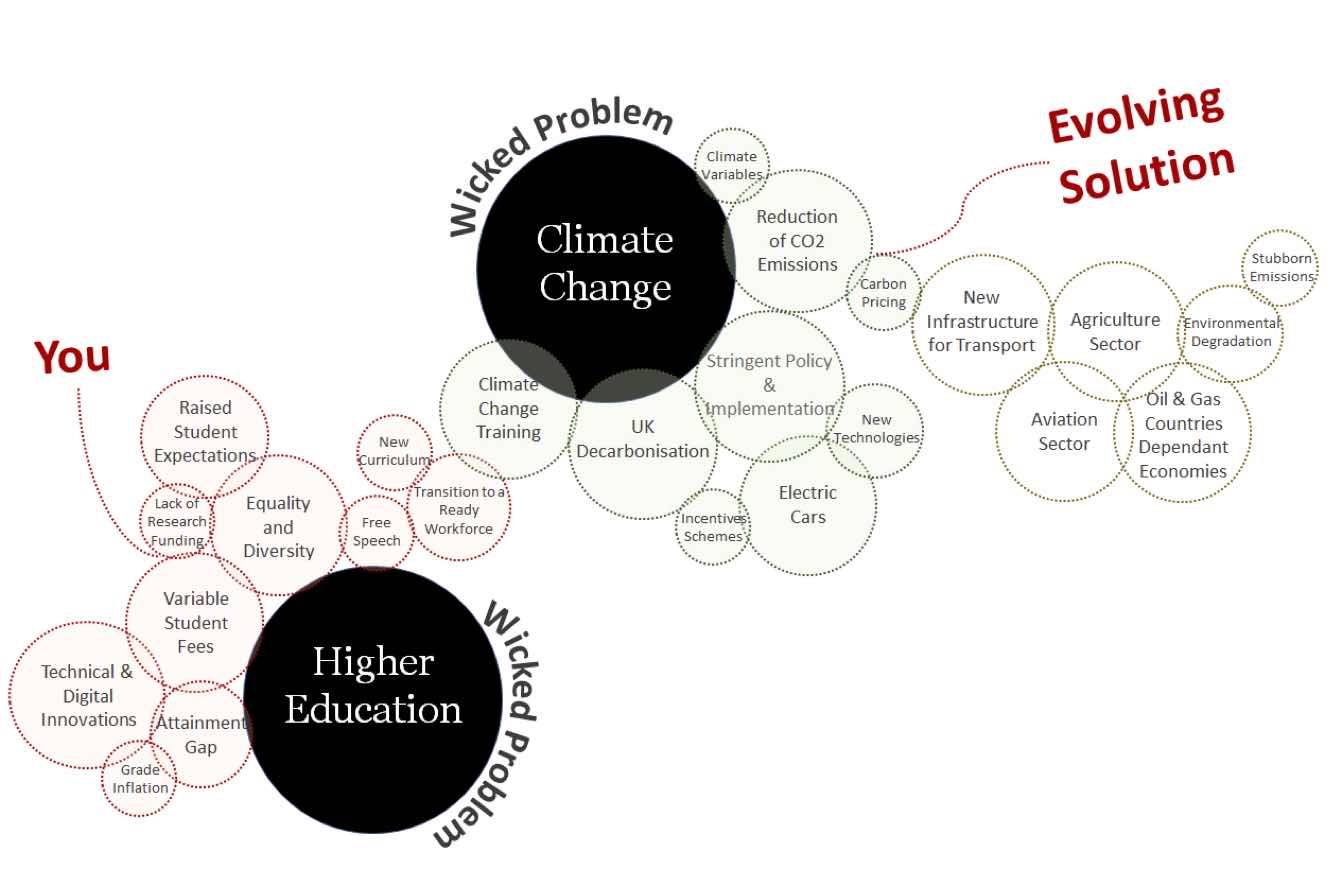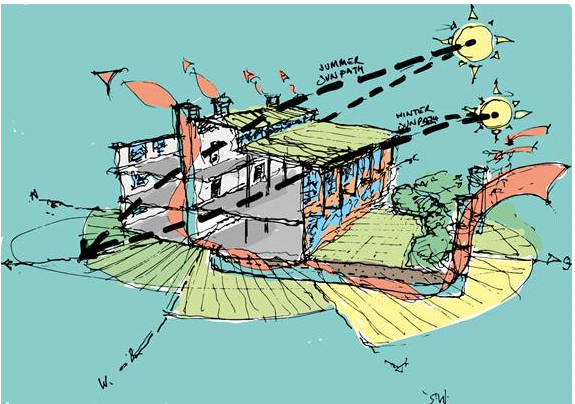
www.buildingsandcities.org/insights/commentaries/higher-education-climate.html
A Wicked Higher Education Problem: Climate Emergency Requires Brave Leadership
This transformation of a university built environment department shows strategic leadership can achieve a zero carbon curriculum.
The B&C special issue EDUCATION & TRAINING: MAINSTREAMING ZERO CARBON raised three challenges: How can education and training be rapidly changed to ensure the creation of zero-carbon built environments? How can this transition be implemented successfully? What positive examples and models can be drawn upon or adapted? Elena Marco responds to these challenges and explains how the Department of Architecture and the Built Environment at UWE Bristol implemented rapid and deep change.
Introduction
Both climate change and higher education are wicked problems. A wicked problem is a complex problem that cannot be resolved without affecting the wider environment in which it sits (Grint, 2010). A firm commitment to decarbonise the UK by 2050 to address climate change means that all emitting sectors would need to develop, implement and maintain very ambitious policy and legislation reform, therefore a whole new systems approach would need to be rapidly developed (Day and Sturge, 2019).
Currently, some UK Higher Education Institutions (HEIs) have declared a climate emergency, without clear ideas of how to transform their curricula and provide future graduates with the knowledge and skills necessary to address climate change. HEIs also face other challenges that are related to student well-being, fairer admission processes, the costs associated with new technological and digital innovations, raised student expectations, variable student fees, research funding concerns, equality and diversity, free speech and grade inflation to name but a few (Parham, 2019). These challenges are coupled with each HEI having a different management structure, where subjects are grouped and led differently. For example, it is not uncommon to find architecture schools separated from other built environment subjects, or built environment subjects as part of much wider natural environment departments. These different management structures within universities can hinder a common approach to addressing climate change within the built environment subjects as a whole.

The many built environment professional bodies do not have a single united approach to address climate change. Therefore, siloes continue to be the norm, not only within the professions themselves, but also within the HEIs. If addressing climate change is the priority, then these siloes need to be broken, and quickly.
Climate change and higher education are two entwined wicked problems (Figure 1). This commentary argues that brave leadership (Grint, 2010) is a viable and much needed approach. If we truly want to transform built environment education to create competent graduates who can address climate change, then changes must occur to the deeply embedded status quo in higher education. Brave leadership within this context means leadership that acknowledges that there isn't a straightforward answer, but finds pragmatic ways to stitch together possible solutions in order to enact change (Grint, 2010).
This case study presented below is of the Department of Architecture and the Built Environment at University of the West of England (UWE Bristol), UK. It shows that the implementation of brave leadership and a strong sustainable strategy to address climate change can transform built environment education.
A Case Study of Transformation
The Department of Architecture and the Built Environment at UWE Bristol is the third largest department of architecture, building and planning subjects in the UK, with 2,500 students across both undergraduate and postgraduate level (HESA, 2020). It houses 12 built environment professions accredited by 10 different professional bodies, each with very different syllabus requirements and even more disparate climate change aspirations.
Five years ago, with a new leadership team, the department made a strategic commitment to address climate change. At the time, only 7 out of 70 members of staff had expertise within sustainability (10% of the department). The department lacked the critical mass of staff, and therefore the drive, to change the curriculum.
The management team quickly realised that in order to change the existing entrenched culture and behaviours, a stronger critical mass of sustainability-aware staff was needed. Attempts to re-skill staff very set in their ways after years of doing things in one way were not having the necessary effect. The department had to address the existing systems-thinking of what was taught and why. A strong strategy to recruit and replace staff, rather than re-skill, was seen as the only way forward. However, in order to recruit staff in the higher education sector, a compelling case for growth is necessary.
Consequently, a sustainable growth plan was put in place that allowed strong sustainability expertise recruitment in all architecture and built environment programmes. This shift also had the unintended consequence of some existing staff deciding to leave, as they disagreed with the department's new strategic focus. This sustainability expertise recruitment was coupled with a diversity drive, to ensure both the required expertise and a notable diversity shift within the staff base. The result is that 34% of the department now has a very strong sustainability expertise across all the programmes and 45% of the department staff are female compared with only 13% in the UK construction industry (Rawlinson, 2019). This shift in the critical mass of the department has enabled curriculum changes and initiatives to ensure this sustainability drive continues to be strengthened, a shift that would not have been possible just by re-skilling. This initially strengthened sustainability within the department's teaching practices and is now also beginning to transform its research focus.
Typically, in Higher Education a programme will go through a process of review every five years, to ensure the programme is up-to-date. In 2018-19 all UWE built environment programmes went through a periodic review with two clear strategic objectives: strengthening the sustainability content in all courses and ensuring that it carefully thought about assessments for well-being. Having staff with the right expertise has led to stronger sustainability content in technology and project management modules and has led to the development of specific sustainability modules in areas such as conservation & retrofit and zero carbon.
UWE's architecture programmes are currently going through a similar periodic review, and are engaging with its student societies in architecture and the built environment, and the Architects Climate Action Network (ACAN), to ensure the student voice is strengthened in the process. In hindsight, strengthening the student voice was perhaps something that could have done better in the earlier built environment refresh.
Whilst
change is now occurring in all of UWE's built environment programmes, there are
still some historical practices from long-serving staff who need to be nudged and
have their assumptions challenged. For example, in the last two years, the
whole department has been asked to change all coursework and studio briefs to
address climate change. This has led to 40% of the departmental coursework and
studio briefs being changed to respond to climate change emergency, compared to
12% previously. While the resistance to changing coursework briefs was greater,
80% of all studio briefs now address the climate change. The students' response
to the studio briefs also needs work, with 40% of students truly engaging with the
sustainable briefs, but 60% still being driven by aesthetics. This raises the
question within universities and their accrediting bodies as to what criteria
should be used for assessing architectural projects? 
These changes have been supported by extra-curricular activities to strengthen the department's strategic focus. For example, in May 2020, the department prepared a free Massive Open Online Course (MOOC) on 'Introduction to Zero Carbon', targeted at built environment professionals who wished to raise their awareness of zero carbon design and construction. The course was run twice, with 422 industry professionals completing the first run and 728 completing the second. The feedback from industry was extremely positive, signalling the need for introductory courses like this to improve the knowledge-base in practice.
This industry-focused course was then re-purposed as part of the department's student induction programme for all architecture and built environment courses. The 'Zero Carbon Aware' module was designed to raise awareness of the social, economic and technical challenges of achieving zero carbon building development, in a proactive and empowering manner. The course was offered to all students in the department, and of the 1,300 who initially signed up, 1,201 completed the course and associated assessment (Figure 2). This means that 48% of all students in the department are now zero-carbon aware. The intention is for this course to become compulsory for all students when they join the department. This course also led to the student societies initiating a series of sustainable live projects, such as a Passivhaus pod and the design and construction of a composting toilet.
Conclusions
This commentary articulates the challenges associated with addressing climate change in a wicked higher education environment. The case study of the Department of Architecture and Built Environment at UWE Bristol shows how a strong, brave leadership has transformed the existing built environment curriculum. However, leadership without a critical mass of like-minded staff and students will achieve very little, and definitely not at the rapid rate that is required. Such leadership also has to acknowledge that intransigent behaviours and a skills deficit continue to stifle real change, showcasing the wickedness of the challenge.
Professional bodies have an important role to play, not only in breaking down industry siloes, but also in ensuring a common purpose across the different professions and a single plan of action to achieve change. Although leadership at departmental level is needed, leadership teams change over time, which raises questions about how continuity can be maintained to ensure there is no change in direction. A sustained long-term approach therefore also depends upon brave top-down leadership from professional bodies and course accreditation organisations. Examples from UWE and elsewhere show what is feasible and achievable. This provides a compelling case to regulatory bodies to raise standards and requirements for built environment education to ensure its workforce is fit for a low carbon future.
Acknowledgements
Thank you to the whole Architecture and Built Environment staff and students, as well as the Architecture Society, the Built Environment Society and WECAN for championing sustainability in everything we do. Special thanks to Patrick O'Flynn who developed the truly inspirational Introduction to Zero Carbon and Zero Carbon Aware courses to take UWE to the next level.
References
Day, G. and Sturge, D. (2019). Rethinking Decarbonisation Incentives: Future Carbon Policy for Clean Growth. Energy Technologies Institute: London.
Grint K. (2010). Wicked Problems and Clumsy Solutions: The Role of Leadership. In: Brookes S., Grint K. (eds) The New Public Leadership Challenge. London: Palgrave Macmillan. https://doi.org/10.1057/9780230277953_11.
HESA (2020). Who's studying in HE? Available from: https://www.hesa.ac.uk/data-and-analysis/students/whos-in-he [Accessed 18/11/2020].
Parnham, C. (2019). 8 of the Greatest Challenges Facing Higher Education in 2020. University Business / The Business of Higher Education. 16th December 2019. Available from: https://universitybusiness.co.uk/business/8-of-the-greatest-challenges-facing-higher-education-in-2020/ [Accessed 18/11/2020].
Rawlinson, S. (2019). Where are the women in the construction workforce?. Building. 19th February 2019. Available from: https://www.building.co.uk/comment/where-are-the-women-in-the-construction-workforce/5097943.article [Accessed 18/11/2020].
Latest Peer-Reviewed Journal Content
Youth engagement in urban living labs: tools, methods and pedagogies
N Charalambous, C Panayi, C Mady, T Augustinčić & D Berc
Co-creating urban transformation: a stakeholder analysis for Germany’s heat transition
P Heger, C Bieber, M Hendawy & A Shooshtari
Placemaking living lab: creating resilient social and spatial infrastructures
M Dodd, N Madabhushi & R Lees
Church pipe organs: historical tuning records as indoor environmental evidence
B Bingley, A Knight & Y Xing
A framework for 1.5°C-aligned GHG budgets in architecture
G Betti, I Spaar, D Bachmann, A Jerosch-Herold, E Kühner, R Yang, K Avhad & S Sinning
Net zero retrofit of the building stock [editorial]
D Godoy-Shimizu & P Steadman
Co-learning in living labs: nurturing civic agency and resilience
A Belfield
The importance of multi-roles and code-switching in living labs
H Noller & A Tarik
Researchers’ shifting roles in living labs for knowledge co-production
C-C Dobre & G Faldi
Increasing civic resilience in urban living labs: city authorities’ roles
E Alatalo, M Laine & M Kyrönviita
Co-curation as civic practice in community engagement
Z Li, M Sunikka-Blank, R Purohit & F Samuel
Preserving buildings: emission reductions from circular economy strategies in Austria
N Alaux, V Kulmer, J Vogel & A Passer
Urban living labs: relationality between institutions and local circularity
P Palo, M Adelfio, J Lundin & E Brandão
Living labs: epistemic modelling, temporariness and land value
J Clossick, T Khonsari & U Steven
Co-creating interventions to prevent mosquito-borne disease transmission in hospitals
O Sloan Wood, E Lupenza, D M Agnello, J B Knudsen, M Msellem, K L Schiøler & F Saleh
Circularity at the neighbourhood scale: co-creative living lab lessons
J Honsa, A Versele, T Van de Kerckhove & C Piccardo
Positive energy districts and energy communities: how living labs create value
E Malakhatka, O Shafqat, A Sandoff & L Thuvander
Built environment governance and professionalism: the end of laissez-faire (again)
S Foxell
Co-creating justice in housing energy transitions through energy living labs
D Ricci, C Leiwakabessy, S van Wieringen, P de Koning & T Konstantinou
HVAC characterisation of existing Canadian buildings for decarbonisation retrofit identification
J Adebisi & J J McArthur
Simulation and the building performance gap [editorial]
M Donn
Developing criteria for effective building-sector commitments in nationally determined contributions
P Graham, K McFarlane & M Taheri
Join Our Community

The most important part of any journal is our people – readers, authors, reviewers, editorial board members and editors. You are cordially invited to join our community by joining our mailing list. We send out occasional emails about the journal – calls for papers, special issues, events and more.
We will not share your email with third parties. Read more



Latest Commentaries
COP30 Report
Matti Kuittinen (Aalto University) reflects on his experience of attending the 2025 UN Conference of the Parties in Belém, Brazil. The roadmaps and commitments failed to deliver the objectives of the 2025 Paris Agreement. However, 2 countries - Japan and Senegal - announced they are creating roadmaps to decarbonise their buildings. An international group of government ministers put housing on the agenda - specifying the need for reduced carbon and energy use along with affordability, quality and climate resilience.
Building-Related Research: New Context, New Challenges
Raymond J. Cole (University of British Columbia) reflects on the key challenges raised in the 34 commissioned essays for Buildings & Cities 5th anniversary. Not only are key research issues identified, but the consequences of changing contexts for conducting research and tailoring its influence on society are highlighted as key areas of action.